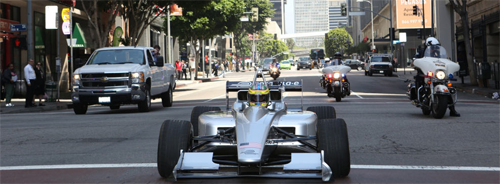The Formula E racing championship, planned to launch next year, won’t just be a demonstration that zero-emissions racing can still be exciting. It’s now looking as if it will be a testing ground for elecricity-based tech.
Qualcomm, best known for making smartphone chips, has signed on as a sponsor. Bur rather than just handing over cash, it will be providing wireless charging technology.
For the first couple of years, that will require the cars to be stationary in the pits. (Some racing enthusiasts believe that this will add to the racing experience as teams will have to balance the time lost to a pit stop with the risk of running out of juice.)
Later on in the five-year deal, though, it plans to use Halo, a system which uses copper pads built into the road surface to create an electromagnetic field when a coil in the vehicles passes over it. A similar technology is already being used on buses in South Korea, though admittedly not at the 130 miles per hour which the Formula E cars are expected to reach.
Qualcomm will also be operating the telemetrics systems that allows crews to remotely check on numerous statistics and condition updates about the cars in real time. The company says it will make these details available to race enthusiasts in a special app.
The app will also use augmented reality for spectators. The idea is that you’ll be able to hold up a mobile device and see live footage of the race that resembles your real view in a particular direction, but with any intervening buildings “removed” from the image.
That’s important as many of the races will take place on city streets, which brings the benefit that some wireless charging pads could be left in place and eventually used by “ordinary” electric car drivers.
Among the vehicles racing in the championship will be Drayson B12 569 which, driven by a British Lord nonetheless, recently became the first all-electric car to beat the 200 mph barrier.
One big aim of the Formula E competition is to inspire drivers by helping challenge the image of electric vehicles as lacking the performance and power of traditional gasoline-fuelled cars.
(Image credit: Formula E)

